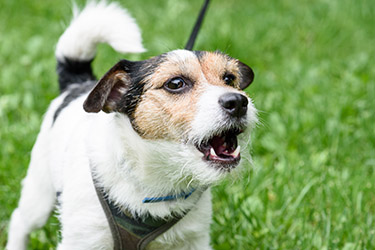What is your dog trying to tell you?

What is your dog trying to tell you?
From howling to “the zoomies,” dogs continue to delight and baffle pet owners with their range of behaviors. While some actions just seem the result of quirky personalities, there are times when dogs really are trying to communicate.
Destructive chewing may be a result of separation anxiety. Other signs include whining, barking, pacing, restlessness, bladder and bowel accidents. Some dogs may even suck or chew on fabric, which some experts believe is due to early weaning.
Food guarding is instinctive for the species, but not desired behavior in a canine companion. Resource guarding may be a result of puppies competing with littermates for limited amounts of food, or from a dog that may have lived as a stray and had to guard its food or territory from other dogs.
Playful mouthing and play biting is easier to control in puppies, and may result in adult dogs that weren’t trained to do otherwise. A playful dog will usually have a relaxed body and face, while an aggressive dog will have a stiff stance and exposed teeth.
Tail chasing can indicate boredom, or can spark a dog’s predatory instinct when he catches movement from the corner of his eye and finds the need to pursue it. Itching caused by parasites or bowel irritation also can be a factor. Puppies tend to chase their tails because they are discovering new things all of the time.
Sound off: understanding barks, whines and growls
Learning to speak dog is an art unto itself. Dogs communicate in a complicated language of barks, whines and growls of varying pitch and frequency. A happy and relaxed dog will emit a higher pitched bark during playtime or when greeting a familiar human, while a lower pitch bark serves as a warning to strangers.
The number of barks also is important. A single bark can indicate surprise, while a frantic string of barking signifies a dog that is on high alert. Even the length of time between barks is subject to scrutiny. A short staccato bark can indicate aggression; a dog seeking attention will pause longer between barks.
Is your dog barking to mark territory, raise an alarm or seek attention? Maybe he’s answering the bark of another dog or greeting someone new. If a dog is confined or anxious, he may repetitively bark out of frustration.
Test your fluency and take the canine bark test.
Strike a pose: reading a dog’s body language
Modern Dog offers a visual representation of reading a dog’s body language. Here are some common signs to signify a dog’s current state of emotion.
- Relaxed/approachable: ears up, tail down and relaxed, mouth slightly open, loose stance
- On alert: tail horizontal with slight wag, ears forward, mouth closed, slight forward lean
- Dominant/aggressive: tail raised and bristled, hackles raised, ears forward, brow wrinkled, lips curled, teeth exposed, legs stiff
- Fearful aggressive: tail tucked, body lowered, hackles raised, ears back, pupils dilated, lips curled
- Stressed: tail down, body lowered, ears back, pupils dilated, rapid panting
- Fearful: tail down, body lowered, ears back, forehead smooth, brief and indirect eye contact, licks air, paw raised
- Extreme fear/submission: tucked tail, exposed belly, ears flat and back, avoids eye contact, may urinate
- Playful: tail up, ears up, pupils dilated, mouth open, front end lowered, ready to run and play
Talk to the tail: interpreting the art of wag
A wagging tail can provide a lot of information about a dog’s emotional state. Tail wagging can be compared to a social communication function similar to a human smile, polite greeting or nod of recognition, a signal that is used when others are around and not when a dog is alone.
Tail position is an important indicator of a dog’s emotional state. Different positions can mean your dog is feeling:
- Happy: tail typically held in neutral or slightly elevated position
- Curious: tail straight out
- Submissive: tail is lowered
- Scared: tail tucked between rear legs
- Aggressive: vertical or arched over back.
- Alert, agitated or watchful: tail and ears are raised
Wag speed is another form of communication. A slight wag may indicate insecurity, while a fast wag at a vertical position can indicate aggression. The faster a dog’s tail wags, the more excited it becomes.
Tail wags can be further dissected by the direction or side to which they wag. A neuroscientist from the University of Trieste in Italy, as well as two veterinarians from the University of Bari, published their findings in Current Biology, noting that familiar or positive stimuli resulted in right-biased tail wag while a more negative stimuli (aggressive, unfamiliar dog) resulted in left-biased tail wag.
At Covetrus North America, we love all things dog. Contact your Covetrus representative for more information at 855.724.3461.
Sources:
https://www.aspca.org/pet-care/dog-care/common-dog-behavior-issues
https://www.caninejournal.com/why-do-dogs-chase-their-tails/
https://www.akc.org/expert-advice/lifestyle/did-you-know/learn-speak-dog-meaning-dogs-barks/
http://www.pbs.org/wgbh/nova/nature/meaning-dog-barks.html
https://moderndogmagazine.com/articles/how-read-your-dogs-body-language/415
https://vcahospitals.com/know-your-pet/interpreting-tail-wags-in-dogs
Need Regulatory Assistance
If you need help with regulatory or licensing issues, we're happy to help. We have a wide variety of resources to help you when issues arise.

Careers
Are you looking for a place to let your talents shine? At Covetrus, we help our practitioner customers better serve their patients and take pride in providing the best customer experience possible. Search our open positions to see our available opportunities.
Newsletter
Stay current with what’s going on with Covetrus, subscribe to receive our newsletter and email communications. Subscribers will receive the latest information in practice management, sales and marketing, animal health, and more.


Leave a comment